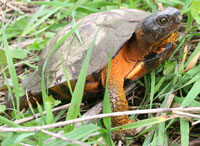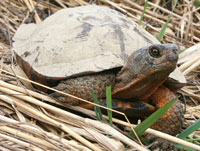Wood turtle
Scientific name: Glyptemys insculpta


Cover photo credits: Joe Crowley (all photos)
Status
Endangered
“Endangered” means the species lives in the wild in Ontario but is facing imminent extinction or extirpation.
Date added to the Species at Risk in Ontario List
The Wood turtle was already assessed as endangered when the Endangered Species Act took effect in 2008.
Read the most recent assessment report (PDF)
What it looks like
Historically, the Wood Turtle was known as “old red leg” owing to the orange or brick-red colour of its legs. A mid-sized turtle, the Wood Turtle reaches its full size of 20-24 cm long around the age of 20.
Unlike other Ontario turtles, these turtles do not shed their scutes (sections of shell), and they develop a rugged, gnarled appearance as they age.
Where it lives
The Wood Turtle prefers clear rivers, streams or creeks with a slight current and sandy or gravelly bottom.
It spends more time on land and the shores of watercourses than other native Ontario turtles.
Wooded areas are essential habitat for the Wood Turtle, but they are found in other habitats, such as wet meadows, swamps and fields. Wood Turtles overwinter on stream bottoms.
Where it’s been found in Ontario
In Ontario, Wood Turtles have been found in three separate regions of the province. Studies are underway to determine more accurately the size and extent of these populations and threats they’re facing. The Wood Turtle is found in isolated patches from Nova Scotia and New Brunswick south to Virginia, and west through southern Quebec and Ontario to Minnesota and northeastern Iowa.
What threatens it
Ontario’s Wood Turtles are at risk from habitat loss and degradation; predation by raccoons, skunks, foxes and pets; human activity such as illegal collection for personal pets or for the pet trade; and road mortality.
This turtle’s slow growth, late maturity and low reproductive success rate increases its vulnerability to all of these threats.
Action we are taking
Endangered Species and their general habitat are automatically protected
Recovery strategy
A recovery strategy advises the ministry on ways to ensure healthy numbers of the species return to Ontario.
Read the executive summary (February 18, 2010)
Read the recovery strategy (February 18, 2010)
Government response statement
A government response statement outlines the actions the government intends to take or support to help recover the species.
Read the government response statement (November 18, 2010)
Five-Year Review of Progress
A five-year review reports on progress made toward protecting and recovering a species, within five years of publishing a species’ government response statement.
Read the report on progress towards the protection and recovery of 13 species at risk, including Wood Turtle (2015)
Habitat protection
A habitat regulation defines a species' habitat and many describe features (e.g., a creek, cliff, or beach), geographic boundaries or other unique characteristics.
Read the regulation (February 18, 2010)
What you can do
Report a sighting
- Report a sighting of an endangered animal or plant to the Natural Heritage Information Centre. Photographs with specific locations or mapping coordinates are always helpful.
Volunteer
- Volunteer with your local nature club or provincial park to participate in surveys or stewardship work focused on species at risk.
Be a good steward
- Private land owners have a very important role to play in species recovery. If you find Wood turtle on your land, you may be eligible for stewardship programs that support the protection and recovery of species at risk and their habitats.
- Every year turtles all over the province must cross busy roads to get to their nesting sites. Road mortality is a major threat to this species. Watch for turtles on the roads, especially May through October. Some municipalities post road signs in areas where turtles are common.
- If you do find an injured Wood Turtle (or any injured native wildlife) you can contact the MNRF for a list of licensed wildlife rehabilitators in your area. Call toll free:
1-800-667-1940 . - Illegal collection for the pet trade of Ontario’s native turtles is jeopardizing this species‘ future. Never purchase wild caught turtles, and never purchase native species of any kind being sold as pets. Keeping Wood Turtles as pets is not allowed in Ontario.
Report illegal activity
- Report any illegal activity related to plants and wildlife to
1-877-TIP-SMNR (847-7667) .
Quick facts
- Although Wood Turtles spend time in wooded areas, that’s not how they got their name. Wood Turtles were named because as they age, their shells take on a wooden appearance..
- Wood Turtles do not begin reproducing until they are at least 17 years old.
- Wood Turtles as old as 46 years old have been found in Ontario.
- Wood Turtles, like all reptiles, are "ectotherms" (often incorrectly called "cold blooded"). This means turtles can’t regulate their own body temperatures. They rely on their environment to warm them up. This is why you can spot turtles basking on logs and rocks on sunny days.
- Wood Turtles are omnivores. They eat insects, slugs, snails, worms, plants, berries, and even fungi. Wood Turtles are one of the few kinds of Ontario turtles that do not need to be under water to swallow their food.
- Wood Turtles have an interesting hunting method; they stomp their feet on the ground to entice worms out of the soil.